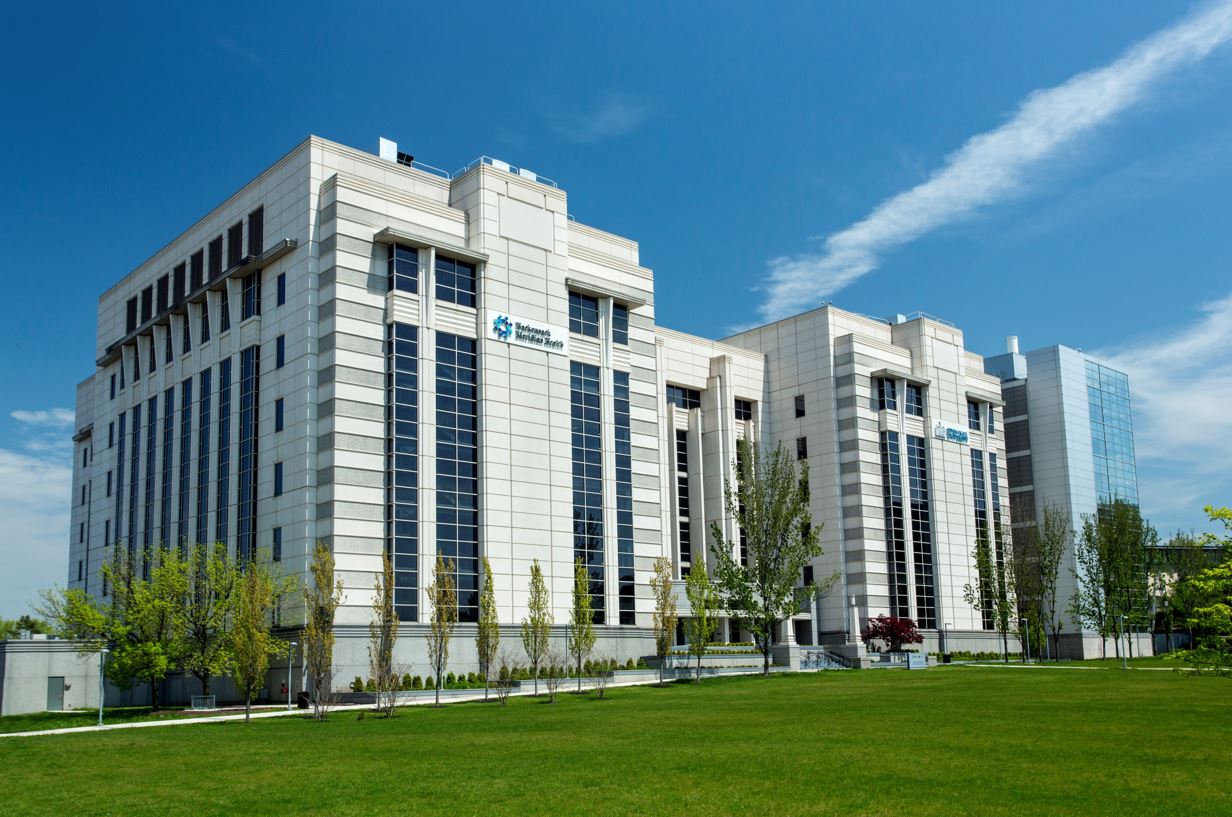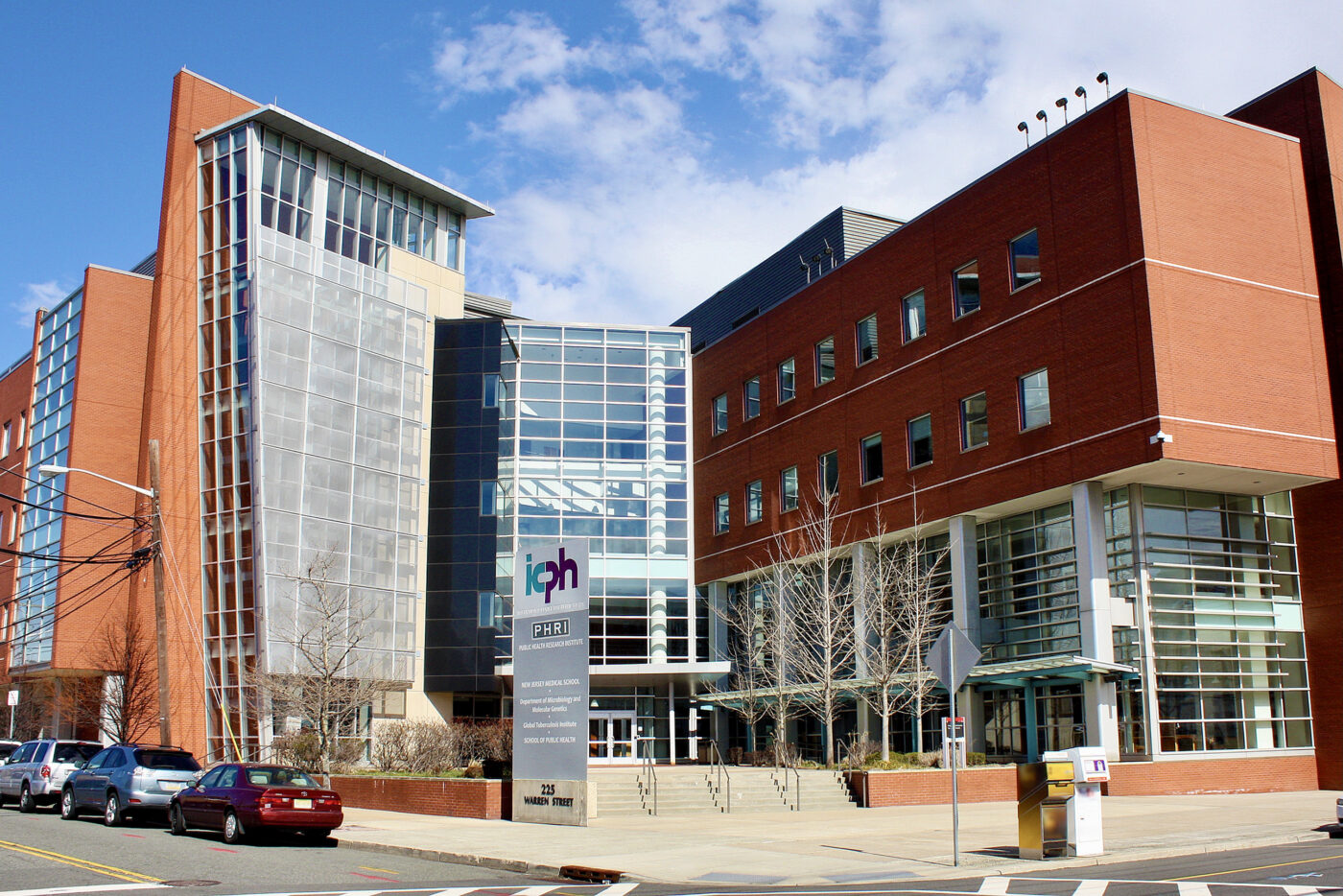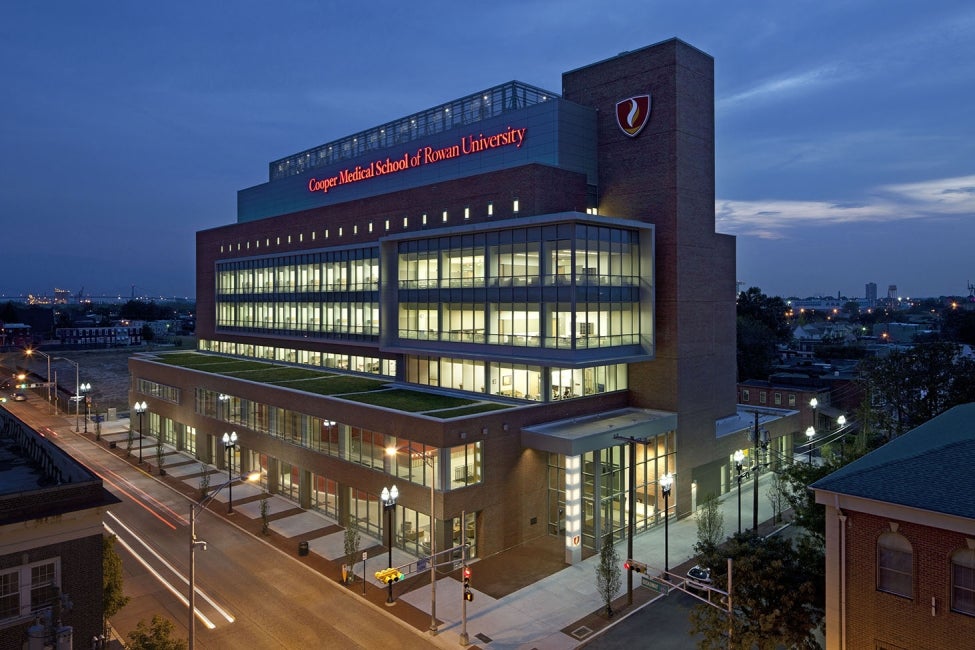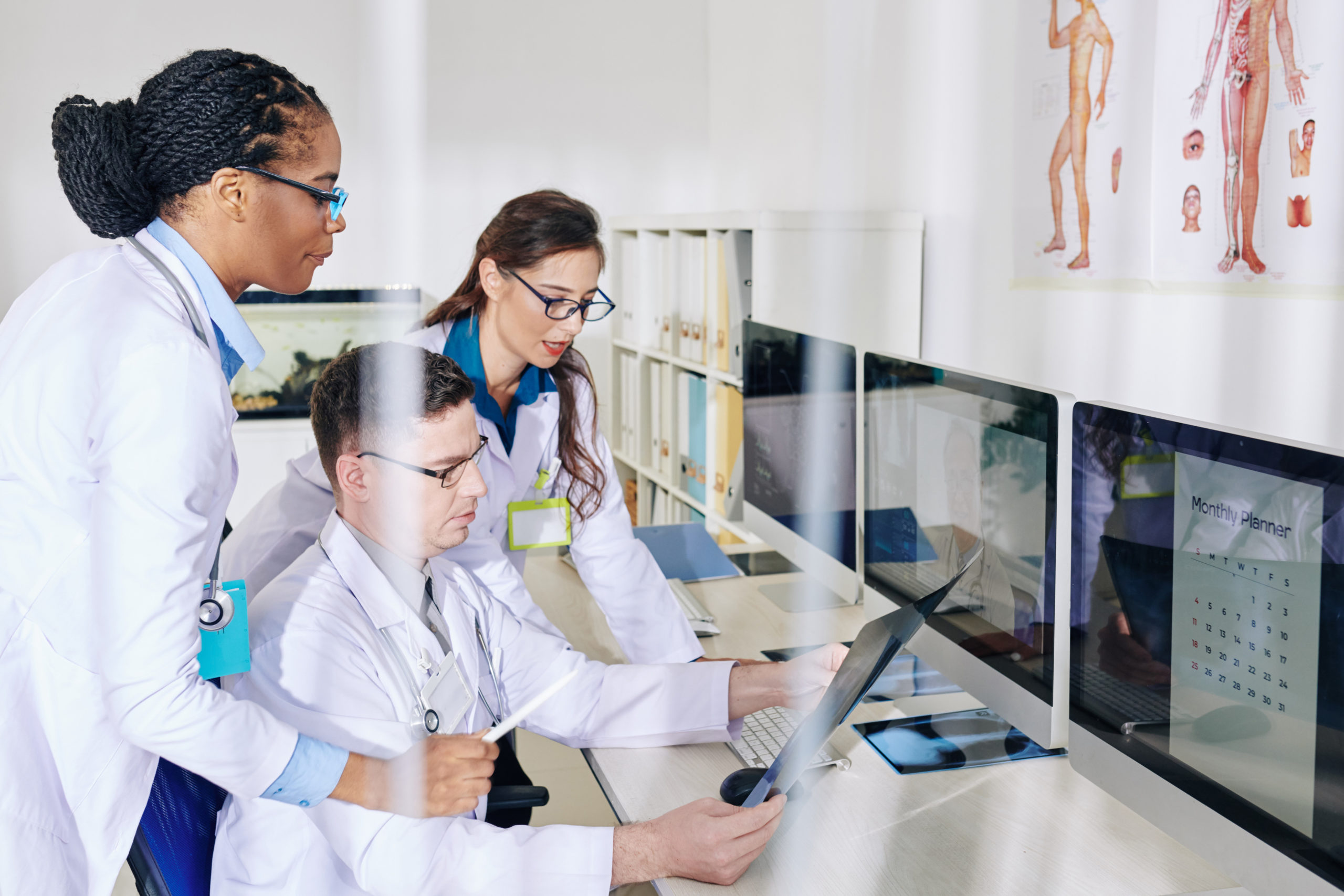With students boasting top COMPLEX exam scores and graduates celebrating a 99% match rate, the Rowan University School of Osteopathic Medicine (Rowan SOM) is a top destination for aspiring osteopathic physicians. The school offers several combined degree programs, community-oriented internships, and has two distinct MD curriculums to choose from.
If you’re looking for osteopathic medical schools in New Jersey, Rowan SOM’s MD and graduate programs are nationally recognized. Regional aspiring physicians who ask, “what are the top New Jersey medical schools?” and “which are the best medical schools near me?” will undoubtedly hear about Rowan SOM’s engaging teaching techniques and community involvement.
So what does it take to get into Rowan SOM? In this guide, we cover everything you need to know, from Rowan’s average GPA and MCAT score to strategies for completing its secondary application. We also provide some expert tips to help you stand out from the rest of the applicant pool.
Be an Informed Applicant
Osteopathic medical schools have similar philosophies on healthcare delivery and medical education. With that said, each school has its own admissions requirements, curriculum, and clinical training opportunities. Researching a medical school will help you craft a focused and effective application that demonstrates fit.
Still, nothing beats one-on-one expert guidance. IMA’s medical school admissions consulting services are designed to give you an edge in the highly competitive application process. Our team of advisors will help you with everything from choosing the right schools to creating a winning application. We’ve helped thousands of medical school applicants just like you get into excellent MD and DO programs across the country.
This article contains:
- Why Rowan SOM?
- DO Program and Combined Degrees
- Selection Factors: What Rowan University School of Osteopathic Medicine Looks for in a Candidate
- Admissions Requirements
- Admissions Statistics
- AACOMAS Primary Application and Rowan SOM Secondary Application
- Rowan SOM Secondary Application: Essay Prompts, Sample Answers, and Advice
- Pre-Med Shadowing Study Abroad Program
- Medical School Admissions Consulting
Why Rowan SOM?
Rowan University’s School of Osteopathic Medicine is recognized for medical education in osteopathic manipulative medicine, geriatric education, and primary care. MD students choose from two pre-clerkship curriculums depending on their learning styles. Early patient encounters, exciting and modern pedagogical techniques, and a commitment to whole-person care for underserved communities are other reasons students choose Rowan.
The school boasts five years of 99% residency match rates and COMPLEX pass rates well above the national average. Located in a Philadelphia suburb, students have plenty of clinical training opportunities in the city while still enjoying a more relaxed lifestyle.
Learn to “DO” – Osteopathic Medicine at Rowan
Founded in 1874 by Andrew Taylor Still, osteopathic medicine was invented to explore new ways of treating patients that avoided harm at all costs. In the late 19th century, many of the early American medications and treatments had adverse effects on patients, so Dr. Still sought to focus medical practice on preventative and integrative care. This “whole person” approach to medicine is still alive and well at Rowan SOM, where students are taught to consider all aspects of a patient’s health in order to create comprehensive treatment plans.
Osteopathic medicine is a branch of medicine that focuses on the musculoskeletal system. Osteopathic physicians (DOs) are trained to identify and treat problems with the bones, joints, muscles, and connective tissues. Osteopathic medicine is unique in that it emphasizes the body’s natural ability to heal itself. DOs use a variety of techniques to assess and treat patients, including manipulative therapy, which is a hands-on approach that uses pressure and stretching to relieve pain and promote healing.
There are many reasons why osteopathic medicine is valuable. First, it is effective in treating a wide range of conditions. Second, it is safe and gentle, with few side effects. Third, it can be used alongside other treatments, such as traditional medicine or surgery. Fourth, it can help people of all ages, from infants to the elderly. Finally, osteopathic medicine addresses the whole person, not just the symptoms of a disease or condition. This holistic approach takes into account psychological and social factors that may be contributing to an individual’s health problem.
Osteopathic medicine is different than allopathic medicine in several ways. First, allopathic physicians (MDs) are trained to treat the body as a collection of separate systems, while DOs view the body as a unified whole. Second, allopathic medicine focuses on using drugs or surgery to treat illness, while osteopathic medicine emphasizes prevention and promoting wellness. Finally, allopathic physicians typically see patients for 15-20 minutes at a time, while DOs often spend 45 minutes or more with each patient to get a comprehensive understanding of their health history and current condition.
For faculty at ROWAN SOM, osteopathic medicine is valuable today because it is effective, safe, gentle, and holistic. If you are looking for a branch of medicine that focuses on overall well-being, then osteopathic medicine may be right for you.
Research at Rowan School of Osteopathic Medicine
Researchers at Rowan SOM have two main areas of focus: Cell Biology and Neuroscience, and Molecular Biology. There are over 20 research facilities at Rowan SOM, and the school boasts cutting-edge research equipment.
Clinical trials by researchers at Rowan SOM are conducted at one of six research centers. Current trials are researching chronic low back pain and fibromyalgia at the NeuroMusculoskeletal Institute, Alzheimer’s Disease and Fragile X Syndrome at the New Jersey Institute for Successful Aging (NJISA), and adverse drug reactions through the Rowan Family Medicine department.
Faculty, medical students, and graduate students at ROWAN SOM are continuously publishing important research that contributes to the medical science community. The school’s website hosts publications by ROWAN SOM’s full-time faculty, students, and volunteer faculty.
Every year, the school hosts Research Day. This annual event highlights important and ground-breaking research conducted by faculty and through partnerships.
Rowan University School of Osteopathic Medicine Rankings
This section summarizes different the rankings and ratings Rowan SOM has received from various publications.
U.S. News and World Report awards Rowan SOM the following:
- #95 in Best Medical School: Research
- #94 in Best Medical School: Primary Care
- #88 in Most Diverse Medical Schools
- #157 in Most Graduates Practicing in Medically Underserved Areas
- #46 in Most Graduates Practicing in Primary Care Fields
Med-Colleges.com gives the school the following ratings:
- Overall: 5/5
- Curriculum: 5/5
- Teaching: 4.5/5
- Safety: 1/5
Among other New Jersey medical schools, Rowan SOM ranks:
- The Third Best Biomedical Sciences School
- The Second Best Physiology & Pathology School
- The Second Best Nutrition & Dietetics School
- The Second Best General Medicine School
- The Second Best Clinical Psychology School
- The Best Alternative Medicine School
Med-Colleges.com also ranks Rowan University School of Osteopathic Medicine as the #6 Best Alternative Medicine School.
Student Organizations
The Rowan University School of Osteopathic Medicine has an active, vibrant, and tight-knit student community. Some of the dozens of student organizations at the school include Wilderness Medicine Club, Student Osteopathic Association of Sports Medicine, Medical Students for Choice, and the LGBTQ Association for Students of Health. The Office of Student Affairs offers logistical and financial support to these student-led organizations.
Volunteering and Community Health
Students at Rowan SOM are encouraged to volunteer at the Rowan Community Health Center and the Rowan SOM OMM Clinic.
Based in Lindenwold, New Jersey, the Rowan Community Health Center is a free clinic operated by Rowan SOM students and faculty. Volunteers get to know the community as well as develop important clinical skills.
The Rowan SOM OMM Clinic is another free clinic that serves the public while providing hands-on training for students. The clinic offers free osteopathic Manipulative Medicine (OMM) treatments to patients with a wide range of conditions such as back pain, neck pain, migraines, anxiety, and more. Being one of the few osteopathic medical schools in New Jersey and the surrounding area, this clinic helps patients (and students looking for “osteopathic medical schools near me”) see the benefits of osteopathic practice first-hand.
There are many more opportunities to volunteer and serve the community through Rowan SOM, such as the student-run Music Medicine program, which uses music therapy for pain management and relaxation, and Project REACH, which teaches preventative health to middle schoolers in Camden.
DO Program at Rowan SOM
Rowan’s Osteopathic MD program is nationally recognized in the fields of manipulative medicine, geriatric education, and primary care. The curriculum is built upon the American Osteopathic Association‘s Seven Competencies:
- Systems-Based Practice
- Practice-Based Learning and Improvement
- Professionalism
- Interpersonal and Communication Skills
- Patient Care
- Medical Knowledge
- Osteopathic Philosophy and Osteopathic Manipulative Medicine
The MD program features two curriculum tracks, Synergistic Guided Learning (SGL) and Problem-Based Learning. Each track uses community-involved primary care projects, a year-one preceptor program, simulators, standardized patient encounters, and small-group sessions. Each track approaches the pre-clerkship years of medical school in a unique fashion with different learning styles and emphases.
Synergistic Guided Learning (SGL)
The SGL curriculum combines organ systems into distinct learning blocks to better facilitate retention and focus in the foundational years of medical school. Blocks present medical concepts in the following sequence: (1) normal and ideal structure of function of an organ system, (2) how diseases progress and affect the system, and (3) how to diagnose and treat the diseases. Didactic coursework and guided small-group classes explore the science of system processes, followed by clinical training sessions that emphasize practical application.
Problem-Based Learning (PBL)
The PBL curriculum puts students in small groups of eight. These groups meet weekly to discuss and ultimately solve clinical cases. The sessions are guided by Rowan’s teaching and clinical faculty to keep discussions productive and on track. Students learn to synthesize information, develop problem-solving skills, and become adept at self-directed learning.
This track requires students that are more independent and self-motivated since there is more opportunity for students to direct their own learning. Those who work well with others and learn through dialogue will likely find this track more engaging.
Combined DO Degrees
The Rowan University School of Osteopathic Medicine offers four dual degree programs.
DO/MBA – This program is designed for students interested in a career in hospital administration or other healthcare management positions. Students learn management, finance, how to work with business partners, and other key business skills. The program takes five years to complete.
DO/MPH – This program is designed for students interested in a career in public health. Students learn about epidemiology, biostatistics, environmental health, and other key public health topics. The program takes five years to complete.
DO/JD – This program is designed for students interested in a career in healthcare law. Students take courses in medical ethics, health policy, and the legal aspects of the healthcare system. The program takes six years to complete and is intended for highly motivated and capable students.
DO/PhD – This program offers a DO degree in combination with a PhD in Molecular Cell Biology and Neuroscience. The program is designed for students interested in a career in biomedical research. The program typically takes seven years to eight years to complete.
Graduate Degrees
Rowan SOM and the Graduate School of Biomedical Sciences offer the following graduate degrees:
- MS in Molecular Pathology and Immunology
- MS in Histopathology
- Master in Biomedical Sciences
- MS in Anatomical Sciences
- MS in Cell and Molecular Biology
- PhD in Cell and Molecular Biology
Selection Factors: What Rowan University School of Osteopathic Medicine Looks for in a Candidate
The admissions committee at Rowan SOM looks for applicants that have demonstrated academic excellence, leadership qualities, and a commitment to service. They want to see that you have taken advantage of all the opportunities available to you and that you can set yourself apart from other applicants.
Here is a list of selection factors that the admissions committee will consider when reviewing your application:
- Undergraduate GPA
- MCAT score
- Clinical experience
- Leadership experience
- Service experience
- Letters of recommendation
- Personal statement
Rowan’s School of Medicine evaluates candidates through holistic reviews. This means that the admissions committee will consider all aspects of your application when making their decision. There is no one specific factor that guarantees admission into the school.
If you want help building a competitive application to Rowan SOM, consider our personalized medical school admissions consulting services. We leverage our expertise in education and medicine to identify your unique strengths and help you craft a compelling candidacy, from optimizing applications to developing a pre-med road map that will set you up for success. Our goal is to help you get into the school of your dreams and shape a career that you love.
Admissions Requirements
After verifying you meet the following admissions requirements for Rowan SOM, you are ready to submit your primary AACOMAS application.
MCAT and GPA
Rowan SOM does not have a required minimum GPA or MCAT score. However, admissions prefers that applicants have an MCAT score of at least 500 and a science GPA no lower than 3.40.
Letters of Recommendation
You are required to submit a letter of recommendation from the pre-med advisory committee at your undergraduate institution, or you may send at least two letters from science professors who have taught and graded you.
Required Coursework
To receive a secondary application from ROWN SOM, you must complete the following prerequisite coursework:
- Biology w/ lab: 8 credit hours
- Organic chemistry w/ lab: 8 credit hours
- Inorganic chemistry w/ lab: 8 credit hours
- Physics w/ lab: 8 credit hours
- Mathematics: 6 credit hours
- Behavioral science (anthropology, sociology, psychology): 6 credit hours
- English: 3 credit hours
- English composition: 3 credit hours
Admissions strongly recommend an additional six credit hours from the following fields: microbiology, anatomy and physiology, and biochemistry.
Admissions Statistics
Here are some key admissions statistics for Rowan University School of Osteopathic Medicine to help you gauge your competitiveness as an applicant and give you a better idea of what the class profile looks like. These numbers reflect the class of 2026.
- 6,145 applicants, 288 admitted
- In-state matriculants: 150
- Out-of-state matriculants: 66
- Cumulative GPA of 3.65
- Science GPA of 3.59
- Average MCAT score of 506
- 59% minority, 41% non-minority
- 16% from underrepresented minority populations
AACOMAS Primary Application and Rowan SOM Secondary Application
The first step in applying to medical school is preparing your primary application. The primary application includes basic facts about you as an applicant, your educational history, and your experiences. This application is completed through AACOMAS (American Association of Colleges of Osteopathic Medicine Application Service). The AACOMAS is then sent to schools you select to apply to.
After reviewing your primary application, you will be invited to complete a secondary application. The secondary application is specific to Rowan SOM. This application includes questions written by the admissions committee to get to know you on a more personal level and determine your fit with the school.
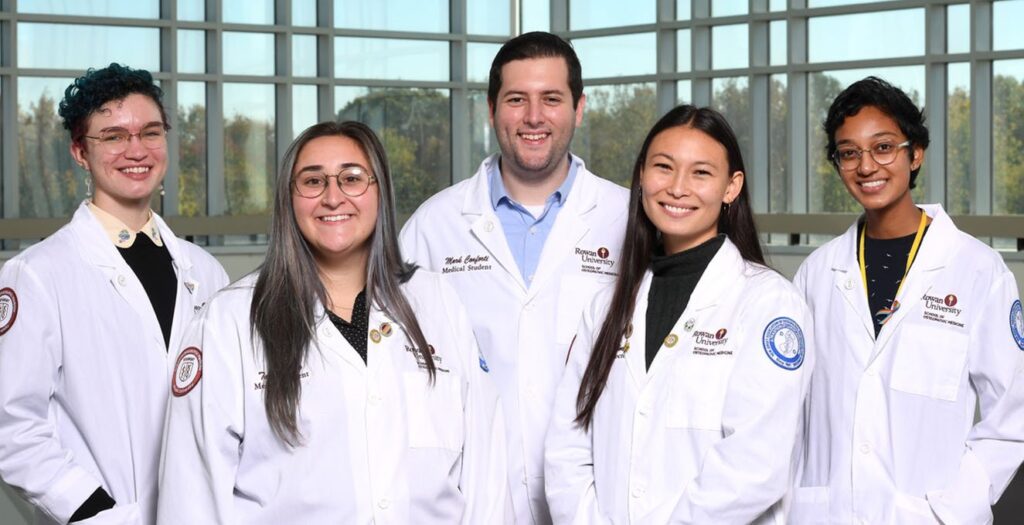
Rowan SOM Secondary Application: Essay Prompts, Sample Answers, and Advice
The secondary application is an opportunity for applicants to Rowan SOM to share information about themselves that may not be evident in their AACOMAS primary application or transcripts. Most importantly, your responses will give the admissions committee a better sense of who you are as a person and how you will contribute to the school community.
When writing your essays, be honest, concise, and authentic. The admissions committee is looking for well-rounded applicants who are not only academically strong but also commit to service and have a desire to become leaders in the field of medicine. Think about what makes you uniquely positioned to benefit from and contribute to Rowan SOM. Your personal history, clinical experiences, and extracurricular activities can all be used to tell your story and demonstrate fit for the school.
Here are some general tips to keep in mind while completing the secondary application for Rowan University School of Osteopathic Medicine:
- Be sure to proofread your essays for grammar and spelling errors before submitting.
- If you are applying to multiple schools, be careful not to reuse essays. Each school is looking for evidence that you are interested in their specific program, so tailor your responses accordingly.
- Don’t be afraid to infuse your personality into your essays. The admissions committee wants to get to know you as a person, so let your unique voice shine through.
- Use concrete examples to illustrate your points. The admissions committee will be more impressed by specific anecdotes than general statements.
- Brainstorm before you begin writing. It can be helpful to jot down a few key points that you want to make sure to cover in each essay.
- If you are struggling to come up with ideas for your essays, reach out to friends and family, mentors, and others who know you well. They may be able to provide insights that you haven’t considered.
Now that you have some general tips to keep in mind, let’s take a closer look at the essay prompts for Rowan SOM’s secondary application. The following prompts are from the 2021-2022 application cycle. No character limit was given.
Essay #1
Depending on which curriculum you pick, either 1a) Please prepare an essay that explains why you want to participate in the Problem Based Learning (PBL) Curriculum and why you are a good fit for this curriculum or 1b) Please prepare an essay that explains why you want to participate in the Synergistic Guided Learning (SGL) Curriculum and why you are a good fit for this curriculum.
The Problem Based Learning (PBL) Curriculum requires students to work in small groups to solve problems. Clinical cases are presented to a group of eight medical students who meet three times a week under the facilitation of a PhD holding physician or clinical professional. Students choose how they learn the scientific concepts necessary to solve problems. Historically, students use a wide range of resources, from classic textbooks and recorded lectures to medical journals and online modules. This type of learning is beneficial for students who are able to think creatively, work collaboratively, and take initiative. If you choose to write about the PBL curriculum, be sure to discuss how your skills and abilities will contribute to the success of your group. You might also want to mention why you are interested in this type of learning environment.
In the Synergistic Guided Learning (SGL) curriculum, students learn medical concepts followed by clinical exercises that allow them to immediately apply what they have learned. This curriculum is based on the principle that students learn best when they can see the relevance of what they are studying. Science and clinical faculty work in teams to design and deliver the curriculum. The SGL curriculum is best for students who want a more traditional medical educational experience with clear learning objectives and clinical relevance. If you choose to write about the SGL curriculum, be sure to discuss how your learning style will allow you to thrive in this type of environment.
Essay #2
Please identify your area of professional interest below (i.e. Family Medicine, Surgery, Pediatrics, etc.)
Your answer to this question will help the admissions committee understand what type of physician you hope to become. Be sure to discuss your interest in the field, as well as any experiences you have had that have helped solidify your decision. You might also want to mention how your interests align with the mission and values of Rowan SOM. For instance, you could explain how an education in osteopathic medicine is useful for someone entering your chosen specialty.
Here’s a sample answer:
“I have been interested in becoming a pediatric physician since I entered high school. My summer jobs have always involved children — from being a camp counselor to working as a nanny — and I have always felt a natural connection to them. In college, I volunteered in a local clinic that provides healthcare to underserved populations, and I was able to see firsthand the difference that a pediatrician can make in the life of a child. I also attended a pre-med shadowing study abroad program with International Medical Aid in my Junior year. There, I was able to observe different medical specialties and confirm that pediatrics was the right fit for me. I enrolled in didactic learning sessions on pediatrics and discussed the details of the profession with my IMA mentor. All the while, we worked with local organizations to provide healthcare and health education to underprivileged children in the community.
I believe the spirit with which Andrew Taylor Still founded the osteopathic school of medicine is especially relevant to pediatrics. His focus on reducing the risk of harm to the patient, using the body’s own ability to heal itself, and using a whole-person approach are all crucial when treating children, who are still growing and developing. I am confident that an education at Rowan SOM will allow me to become the best pediatrician possible and make a positive impact on the health of children everywhere.”
In this essay, the applicant has written about her interest in pediatrics, and how her personal and professional experiences have helped to solidify this decision. She has also discussed how osteopathic medicine is especially relevant to her chosen specialty. This is a strong answer that will give the admissions committee a good sense of what motivates the applicant to apply to Rowan SOM and what she hopes to accomplish as a future physician.
Essay #3
How did you learn about osteopathic medicine and why is it a good fit for you?
This question is designed to help the admissions committee understand your motivation for applying to Rowan SOM. Be sure to discuss your research into the DO profession, as well as any personal experiences you have had that have led you to this decision. You might also want to mention how osteopathic medicine aligns with your personal values and goals. For instance, you could explain how the focus on whole-person care is especially important to you.
Here’s a sample answer:
“I first learned about osteopathic medicine while shadowing a family friend who is an Osteopathic Physician. I was struck by the emphasis he placed on preventative care and impressed with his patient’s feedback on Osteopathic Manipulative Therapy. I also appreciated the fact that he took the time to get to know his patients on a personal level.
I did some additional research into osteopathic medicine and found that it aligned well with my personal values. I believe that taking a holistic approach to medicine is important, as it allows for better prevention and treatment of disease. I also think that it is crucial to build strong relationships with patients to provide the best possible care.
An education at Rowan SOM will allow me to become a well-rounded physician who can provide comprehensive, individualized, holistic care. I am confident that this is the right decision for me, and I am excited to begin my journey at Rowan SOM.”
In this answer, the applicant discusses her initial exposure to osteopathic medicine, as well as the research she has done into the profession. She also explains how osteopathic medicine aligns with her personal values and why she thinks it is the right fit for her.
Essay #4
Explain why you are interested in attending Rowan University School of Osteopathic Medicine.
This question gives you the opportunity to show that you have done your research into Rowan SOM and that you are confident that it is the right fit for you. Be sure to mention specific aspects of the school that appeal to you, such as the curriculum, faculty, clinical training opportunities, etc.
In the sections above, we detailed everything that makes Rowan University School of Osteopathic Medicine unique. Before answering this prompt, refamiliarize yourself with the school’s approach to medical education. What sets Rowan SOM apart from other osteopathic schools? How does it align with your personal and professional goals?
Make sure to back up your claims with specific examples. For instance, if you mention that you are impressed with the school’s clinical training opportunities, mention a specific program or rotation that you are interested in.
Finally, avoid simply listing the school’s positive attributes. Instead, focus on how those attributes will benefit you and help you to achieve your goals. For example, don’t simply say that the school has a great curriculum; explain how the curriculum will help you to become a better physician. If you value the school’s focus on whole-person care, explain how that focus will benefit your future patients.
Essay #5 (Optional Essay)
Please describe any significant barriers or challenges you may have overcome in the pursuit of your personal/professional goals.
This is an interesting question. Rather than asking for examples of overcoming adversity in your past, this question asks what challenges, if any, you expect to face in your future.
There are a few different ways to approach this question. You could discuss a specific challenge that you expect to face during your time in medical school or as a practicing physician. Alternatively, you could discuss how you plan to deal with the stress of medical school and/or your future career. Finally, you could describe how your unique experiences have prepared you to face any challenges that come your way.
A strong response to this prompt will demonstrate foresight, maturity, and a commitment to overcoming any obstacles in your path. Being realistic about the challenges you may face shows that you are prepared to deal with them constructively.
Start by brainstorming: What are some challenges that medical students and physicians have to overcome to reach their personal and professional goals?
There are several challenges that medical students and physicians face. Some of these include:
- Dealing with the stress of medical school and/or a medical career
- Facing difficult ethical decisions
- Providing care for patients with complex needs
- Balancing work and personal/family responsibilities
- Lack of diversity in the medical field
- Making time for self-care
- Maintaining a positive outlook during difficult times
However, each individual has different experiences, goals, and challenges. Think about what unique challenges you may face during your time in medical school and/or your future career.
How have you prepared to overcome these challenges? What resources do you have in place to help you deal with them effectively? Be sure to discuss how your unique experiences and qualities will contribute to your success in overcoming these challenges.
Overall, this is an opportunity to show that you are aware of the challenges of a career in medicine and that you have thought about how you will deal with them. Be honest and open in your response, but also be sure to focus on the positive. Discuss how you will use any challenges or obstacles as opportunities to grow and learn.
Stand Out with IMA’s Pre-Med Shadowing Study Abroad Program
IMA offers a unique opportunity for pre-med students to combine clinical shadowing with service learning, didactic specialty sessions, and medical school admissions consulting. Among other things, our program offers students the chance to gain valuable clinical experience while exploring a new culture and gaining an international perspective on healthcare.
In addition to the skills, knowledge, and unforgettable experiences, IMA’s pre-med internships provide medical school applicants with powerful centerpieces for applications and interviews. Due to the breadth of the program, our students often come away from the experience with new interests, a better sense of what they want to pursue in medicine, and impressive stories to share with admissions committees. Each element of our study abroad internships is designed to help our interns stand out in the medical school admissions process while gaining the skills and experiences they need to succeed in their future medical careers.
Take a moment to learn more about this unique opportunity and how it can benefit your medical school application.
Medical School Admissions Consulting
Included in our pre-med shadowing program or available as a separate service, IMA also offers personalized medical school admissions consulting. Our team of expert consultants will work with you one-on-one to help you develop a competitive and successful medical school application.
We understand that the medical school admissions process can be daunting, and we’re here to help you navigate it successfully. Our medical school admissions consultants will help you identify your strengths, choose the right schools, write strong essays, ace your interviews, and much more. We’ll be with you every step of the way, providing guidance, support, and expert advice.
If you’re interested in learning more about our medical school admissions consulting services, schedule a free consultationand we’ll begin developing a personalized plan to help you achieve your goals.
Good Luck to You!
Applying to medical school is a challenging and exciting process. We hope this guide has provided you with the information you need to get started on your journey. If you have any questions or would like more information about our programs, please contact us.
We have many more medical school guides, so make sure to check them out!
- Hackensack Meridian School of Medicine (HMSOM)
- Rutgers New Jersey Medical School (NJMS)
- Rutgers Robert Wood Johnson Medical School
- Cooper Medical School of Rowan University (CMSRU)
- A.T. Still University Kirksville College of Osteopathic Medicine
- Saint Louis University School of Medicine
- University of Missouri Medical School
- Kansas City University (KCU)
- UMKC School of Medicine
- New York Medical College
- University of Pittsburgh School of Medicine
- University of Wisconsin Medical School
- VCU School of Medicine
- University of Maryland School of Medicine
- Case Western Medical School
- University of North Carolina Medical School
- University of Florida Medical School
- Emory University School of Medicine
- Boston University College of Medicine
- California University of Science and Medicine
- UC San Diego Medical School
- California Northstate University College of Medicine
- Touro University of California
- CHSU College of Osteopathic Medicine
- UC Davis School of Medicine
- Harvard Medical School
- UC Riverside School of Medicine
- USC Keck School of Medicine
- UT Southwestern Medical School
- Long School of Medicine at UT Health San Antonio
- University of the Incarnate Word School of Osteopathic Medicine
- UT Austin’s Dell Medical School
- UTMB School of Medicine
- McGovern Medical School at UT Health
- Johns Hopkins School of Medicine
- McGovern Medical School at UT Health
- The University of Texas Rio Grande Valley School of Medicine
- UNT Texas College of Osteopathic Medicine
- University of Houston College of Medicine
- Texas A&M College of Medicine
- Johns Hopkins Medical School
- Baylor College of Medicine
- George Washington University School of Medicine
- Vanderbilt University School of Medicine
- St. George’s University School of Medicine
- Lake Erie College of Osteopathic Medicine (in Pennsylvania)
- Sidney Kimmel Medical College at Thomas Jefferson University
- Wake Forest University School of Medicine
- Western University of Health Sciences (in California)
- Drexel University College of Medicine
- Stritch School of Medicine at Loyola University Chicago
- Georgetown University School of Medicine
- Yale School of Medicine
- Perelman School of Medicine
- UCLA Medical School
- NYU Medical School
- Washington University School of Medicine
- Brown Medical School
We wish you luck in your medical school journey!


